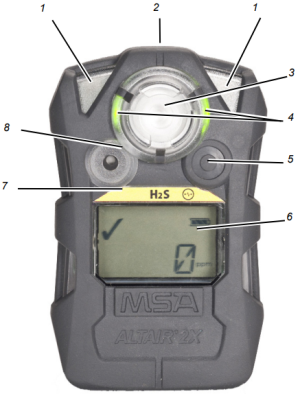Description
Overview
|
1 |
Alarm LED (red) |
5 |
Button (ON/OFF / multi-function) |
|
2 |
Infrared port |
6 |
Display with backlight |
|
3 |
Sensor cover |
7 |
Gas type |
|
4 |
Safe LED (green) |
8 |
Audible alarm transmitter |
The device monitors gases in ambient air and in the workplace. The following toxic gases can be monitored in the ambient air:
| • | Sulfur dioxide (SO2) |
| • | Nitrogen dioxide (NO2) |
| • | Carbon monoxide (CO) |
| • | Hydrogen sulfide (H2S) |
| • | Chlorine (Cl2) |
| • | Ammonia (NH3) |
The Two Gas (Two-Tox) sensor provides two sensing capabilities in a single sensor. The following combinations are possible:
| • | Carbon monoxide/hydrogen sulfide (CO/H2S) |
| • | Carbon monoxide/nitrogen dioxide (CO/NO2) |
| • | Hydrogen sulfide/sulfur dioxide (H2S/SO2) |
The alarm levels for the individual gases are factory-set and and cannot be changed during operation. Changes can only be made through MSA Link™ software.
Short Term Exposure Limits (STEL)
The STEL alarm is calculated over a 15 minute exposure.
STEL calculation examples:
Assume the device has been running for at least 15 minutes:
15 minute exposure of 35 ppm:
|
(15 minutes x 35 ppm)
|
= 35 ppm |
|
15 minutes |
10 minute exposure of 35 ppm and 5 minutes exposure of 5 ppm:
|
(10 minutes x 35 ppm) + (5 minutes x 5 ppm)
|
= 25 ppm |
|
15 minutes |
If the device is on for longer than 15 minutes, the STEL is calculated for the most recent fifteen minutes of runtime.
Time Weighted Average (TWA)
The TWA alarm is calculated over an eight-hour exposure.
TWA calculation examples:
1 hour exposure of 50 ppm:
|
(1 hour x 50 ppm) + (7 hours x 0 ppm)
|
= 6.25 ppm |
|
8 hours |
4 hour exposure of 50 ppm and 4 hour exposure of 100 ppm:
|
(4 hours x 50 ppm) + (4 hours x 100 ppm)
|
= 75 ppm |
|
8 hours |
12 hour exposure of 100 ppm:
|
(12 hours x 100 ppm)
|
= 150 ppm |
|
8 hours |
If the device is ON for less than 8 hours (480 minutes), the balance of the minute ppm values is set to zero.
